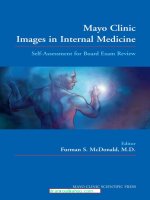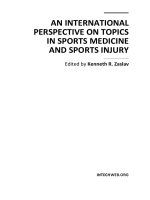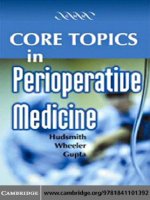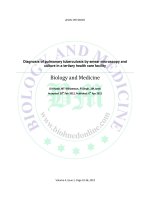CORE TOPICS IN PERIOPERATIVE MEDICINE docx
Bạn đang xem bản rút gọn của tài liệu. Xem và tải ngay bản đầy đủ của tài liệu tại đây (3.52 MB, 298 trang )
CORE TOPICS IN PERIOPERATIVE MEDICINE
CORE TOPICS IN PERIOPERATIVE
MEDICINE
by
Jonathan Hudsmith BM FRCA
Department of Anaesthesia
Peterborough Hospitals NHS Trust
Dan Wheeler MA BM BCh MRCP FRCA
Clinical Lecturer in Anaesthesia
University of Cambridge
Arun Gupta MA MBBS FRCA
Director of Postgraduate Medical Education
University of Cambridge
London ♦ San Francisco
cambridge university press
Cambridge, New York, Melbourne, Madrid, Cape Town, Singapore, São Paulo
Cambridge University Press
The Edinburgh Building, Cambridge cb2 2ru, UK
First published in print format
isbn-13 978-1-841-10139-2
isbn-13 978-0-511-16584-9
© Greenwich Medical Media Limited 2004
2004
Information on this title: www.cambrid
g
e.or
g
/9781841101392
This publication is in copyright. Subject to statutory exception and to the provision of
relevant collective licensing agreements, no reproduction of any part may take place
without the written permission of Cambridge University Press.
isbn-10 0-511-16584-6
isbn-10 1-841-10139-7
Cambridge University Press has no responsibility for the persistence or accuracy of urls
for external or third-party internet websites referred to in this publication, and does not
guarantee that any content on such websites is, or will remain, accurate or appropriate.
Published in the United States of America by Cambridge University Press, New York
www.cambridge.org
p
a
p
erback
eBook (NetLibrary)
eBook (NetLibrary)
p
a
p
erback
Contents
Preface vii
Contributors ix
1.Perioperative management of cardiovascular disease 1
John McNamara
2.Perioperative management of respiratory disease 13
Tim Clarke
3.Perioperative care of children 19
Warren Fisher
4.Perioperative management of the obese patient 25
Anand Sardesai
5.Perioperative management of the elderly patient 33
Karen Pedersen
6.Perioperative management of emergency surgery 43
Jeremy Lermitte and Jonathan Hudsmith
7.Perioperative fluid management 55
Iain MacKenzie
8.Perioperative management of coagulation 65
Andy Johnston
9.Perioperative management of steroid therapy 73
Fraz Mir and Michael Lindop
10.Perioperative management of endocrine disease 79
Dan Wheeler and Ingrid Wilkins
11.Perioperative management of diabetes 91
Mike Masding and Wendy Gatling
12.Causes and treatment of aspiration 99
Paul Hughes
13.Transfusion and blood products 105
Andy Johnston
14.The critically ill patient 111
Vilas Navapurkar
15.Inotropes 121
Andy Gregg
16.Arterial blood gases 127
Simon Fletcher
17.Drugs used in anaesthesia and sedation 137
Mike Palmer
18.Local anaesthetics 145
Sue Abdy
19.Monitoring used in the perioperative period 153
Ian Bridgland and Katrina Williams
20.Deep vein thrombosis and thrombo-embolic disease prophylaxis 165
Jonathan Hudsmith
21.Postoperative nausea and vomiting 173
Pete Young
22.The management of perioperative pain 179
Parameswaran Pillai and Richard Neal
23.High dependency and recovery units 191
Helen Smith
24.Postoperative hypoxia 199
Mark Abrahams
25.Postoperative hypotension 207
Chris Sharpe
26.Postoperative complications 213
Dan Wheeler and Jeremy Lermitte
27.Perioperative scenarios 237
Dan Wheeler and Parameswaran Pillai
28.Multiple choice questions 257
Quentin Milner
Index 277
Contents
vi
Preface
Undergraduate medical education is continuously changing to meet
the requirements for the training of future medical practitioners. Over
the last few years the concept of perioperative medicine has evolved
encompassing the preoperative assessment and optimisation of patients,
the intraoperative and postoperative management of these patients and
importantly the recognition, diagnosis and treatment of the critically ill
patient. The relevance of this to undergraduate medical students is
undeniable and a number of medical schools have now incorporated
a module of Perioperative Medicine into their curricula for medical
students.
The aims of this book are to provide concise, informative chapters on
many aspects of perioperative medicine, allowing medical students to
bridge the gap between their clinical attachment in this specialty, first year
house officer jobs and preparation for postgraduate examinations. We
make no apology for repeating important messages and subsequently
there may be some crossover of subject matter between chapters.
Changes to the structure of Senior House Officer training will result in
incorporation of a Foundation year for the majority of newly qualified
doctors. This book covers many of the situations and problems that these
doctors will have to face. By providing a broad overview of the
perioperative period, this text can be a very useful quick reference guide.
Effectively caring for patients in the perioperative period is a complex
and demanding job. Doctors and nurses need to be able to detect early
signs of any problems during this time, so that interventions can be
planned to optimise outcome for their patients. This book should help
staff achieve this goal.
This book will also be useful to those preparing for Surgical, Anaesthetic
and Accident and Emergency postgraduate examinations. Nurses and
other healthcare professionals, who are taking on increasing clinical
responsibilities within the perioperative period, will also find this book
invaluable.
Jonathan Hudsmith
Dan Wheeler
Arun Gupta
August 2003
Contributors
Sue Abdy MBBS DRCOG FRCA
Department of Anaesthesia
Queen Elizabeth Hospital, King’s Lynn
Mark Abrahams MBChB DA FRCA
Department of Anaesthesia
Norfolk & Norwich University Hospital NHS Trust
Ian Bridgland MBBS MSc DRCOG FRCA FANZCA
Department of Anaesthesia
St. Vincent’s Hospital, Sydney, Australia
Tim Clarke MBChB FRCA
Department of Anaesthesia
Blackburn Royal Infirmary
Warren Fisher MBChB FRCA
Department of Anaesthesia
Royal Berkshire Hospital, Reading
Simon Fletcher MBBS FRCA
Department of Anaesthesia
Norfolk & Norwich University Hospital NHS Trust
Wendy Gatling MBChB DM FRCP
Department of Medicine & Diabetes Centre
Poole Hospital NHS Trust
Andy Gregg BM MRCP FRCA
Neurocritical Care Unit
Addenbrooke’s NHS Trust, Cambridge
Arun Gupta MA MBBS FRCA
Director of Postgraduate Medical Education
University of Cambridge
Jonathan Hudsmith BM FRCA
Department of Anaesthesia
Peterborough Hospitals NHS Trust
Paul Hughes MBChB FRCA
Department of Anaesthesia
Peterborough Hospitals NHS Trust
Andrew Johnston MA MB BChir FRCA
Department of Anaesthesia
Addenbrooke’s NHS Trust, Cambridge
Jeremy Lermitte BM FRCA
Department of Anaesthesia
Addenbrooke’s NHS Trust, Cambridge
Michael Lindop MA MB BChir FRCA
Department of Anaesthesia
Addenbrooke’s NHS Trust, Cambridge
Iain MacKenzie DM MRCP FRCA
Department of Anaesthesia
Addenbrooke’s NHS Trust, Cambridge
John McNamara MBBS FRCA
Department of Anaesthesia
Bedford Hospital
Mike Masding MBBS MRCP
Department of Medicine & Diabetes Centre
Poole Hospital NHS Trust
Quentin Milner MBChB FRCA
Department of Anaesthesia
Queen Alexandra Hospital, Portsmouth
Fraz Mir BSc MBBS MRCP
Department of Intensive Care
Addenbrooke’s NHS Trust, Cambridge
Vilas Navapurkar MBChB DA FRCA
Department of Anaesthesia
Addenbrooke’s NHS Trust, Cambridge
Richard Neal MA MB BChir
Department of Paediatrics
Kings Mill Hospital, Mansfield
Contributors
x
Mike Palmer BPharm PhD MBBS FRCA
Department of Anaesthesia
West Suffolk Hospital, Bury St. Edmunds
Karen Pedersen MBBCh FANZCA
Department of Anaesthesia
Auckland Hospital, New Zealand
Parameswaran Pillai MD FRCA
Department of Anaesthesia
Addenbrooke’s NHS Trust, Cambridge
Anand Sardesai MBBS MD DA FRCA
Department of Anaesthesia
Addenbrooke’s NHS Trust, Cambridge
Christopher Sharpe MBBS FRCA
Department of Anaesthesia
Norfolk & Norwich University Hospital NHS Trust
Helen Smith MBBS FRCA
Department of Anaesthesia
Addenbrooke’s NHS Trust, Cambridge
Dan Wheeler MA BM BCh MRCP FRCA
Clinical Lecturer in Anaesthesia
University of Cambridge
Ingrid Wilkins BSc FRCA
Department of Anaesthesia
Addenbrooke’s NHS Trust, Cambridge
Katrina Williams BSc MBChB FRCA
Department of Anaesthesia
Norfolk & Norwich University Hospital NHS Trust
Peter Young MD FRCA
Department of Anaesthesia
Queen Elizabeth Hospital, King’s Lynn
xi
Contributors
Perioperative management
of cardiovascular disease
John McNamara
Introduction 2
Assessment via history, examination and investigations 2
Cardiac risk and surgery 4
Cardiac risk and anaesthesia 4
Ischaemic heart disease and angina 6
Hypertension 7
Cardiac failure 7
Cardiac dysrhythmias 7
Valvular heart disease 8
Pacemakers 8
1
1
Introduction
Cardiovascular disease is common in the surgical population, occurring in
at least 10% of patients presenting for surgery. Their assessment can be
broadly divided into consideration of the following:
1. Ischaemic heart disease
2. Hypertension
3. Cardiac failure
4. Cardiac arrhythmias and pacemakers
5. Valvular disease
The reason for assessing patients before surgery is to:
1. Make an estimate of their risk of cardiovascular morbidity and mortality
2. Make a plan to investigate and intervene to optimise the patient’s
condition if possible
3. Plan the operation and anaesthetic technique
4. Arrange appropriate postoperative monitoring and treatment
Assessment via history, examination and investigations
History should particularly focus on the patient’s functional ability. The
American College of Cardiology and American Heart Foundation have
devised a method of assessing function by means of simple questions about
activity, and quantified the physiological reserve required to attain certain
levels of activity using ‘metabolic equivalent tasks (METs)’ (Table 1.1).
It is also important to consider:
any previous admissions with cardiac conditions
exercise limits, on the flat and up stairs (e.g. how many flights?)
precipitants and frequency of angina, frequency of use of nitrate spray
or tablets
symptoms of cardiac failure – paroxysmal nocturnal dyspnoea, ankle
oedema
if hypertensive, history of control/previous readings
pacemakers – type, recent checks and indication for insertion
Examination should include a full cardiovascular assessment and blood
pressure. Investigations will follow local guidelines, in particular an ECG
should be ordered for any patient with cardiovascular disease and a chest
X-ray ordered for any patient with cardiac related respiratory symptoms.
Most murmurs will require an echocardiogram. An echocardiogram is also
useful to assess moderate to severe heart failure.
Core topics in perioperative medicine
2
1
3
Perioperative management of cardiovascular disease
1
Table 1.1 Estimated energy requirements for various activities
1 MET
Can you take care 4 METs
Climb a flight of stairs or
of yourself? walk up a hill?
Eat, dress, or use
Walk on level ground
the toilet? at 4 mph or 6.4 km/h?
Walk indoors around
Run a short distance?
the house?
Walk a block or two
Do heavy work around
on level ground the house like scrubbing
at 2–3 mph or floors or lifting or
3.2–4.8 km/h? moving heavy furniture?
4 METs
Do light work around
Participate in moderate
the house like dusting recreational activities like
or washing dishes? golf, bowling, dancing,
doubles tennis, or
throwing a baseball
or football?
Ͼ10 METs
Participate in strenuous
sports like swimming,
singles tennis, football,
basketball, or skiing?
MET indicates metabolic equivalent.
Adapted from the Duke Activity Status Index (Hlatky MA, Boineau RE, Higginbotham MB,
Lee KL, Mark DB, Califf RM, Cobb FR, Proyr DB. A brief self-administered
questionnaire to determine functional capacity [the Duke Activity Status Index]. Am J
Cardiol 1989; 64: 651–654) and AHA Exercise Standards (Fletcher GF, Balady G, Froelicher
VF, Hartley LH, Haskell WL, Pollock ML. Exercise standards: A statement for healthcare
professionals from the American Heart Association. Circulation 1995; 91: 580–615).
Findings of concern/liaise with anaesthetist
1. myocardial infarct (MI) within the past 6 months
2. unstable/increasing angina
3. poorly treated cardiac failure (unable to lie flat with 2 pillows)
4. severe exercise limitation – symptoms on less than ordinary activity
5. untreated cardiac arrhythmias
6. systolic blood pressure Ͼ200 mmHg, diastolic blood pressure
Ͼ100 mmHg
7. murmurs without a recent echocardiogram
Cardiac risk and surgery
Surgery stresses the cardiovascular system, the extent depending on a
patient’s age, urgency of surgery, site of surgery and length of surgery. The
American College of Cardiology and American Heart Foundation have
stratified cardiac event risk for non-cardiac surgery (Table 1.2).
Cardiac risk and anaesthesia
Anaesthesia also poses a significant stress to the cardiovascular system.
The important risk factors for perioperative cardiac morbidity and
mortality were identified by Goldman as long ago as the 1970s (Table 1.3).
This index has a high specificity but low sensitivity, in other words it
correctly identifies those at high risk by their high score but does not
identify all high risk patients. Subsequent revisions and modifications have
been made, but the Goldman index is still widely used to assess
postoperative cardiac risk.
Core topics in perioperative medicine
4
1
Table 1.2 Cardiac event risk* stratification for non-cardiac surgical
procedures
High Intermediate Low
†
(Reported cardiac risk (Reported cardiac risk (Reported cardiac risk
often Ͼ5%) generally Ͻ5%) generally Ͻ1%)
Emergent major
Intraperitoneal and
Endoscopic
operations, particularly intrathoracic surgery procedures
in the elderly
Aortic and other major
Carotid endarterectomy
Superficial
vascular surgery surgery procedures
Peripheral vascular
Head and neck surgery
Cataract surgery
surgery
Anticipated prolonged
Orthopedic surgery
Breast surgery
surgical procedures
associated with large
fluid shifts and/or
blood loss
Prostate surgery
*Combined incidence of cardiac death and non-fatal myocardial infarction.
†
Further preoperative cardiac testing is not generally required.
It is extremely important to identify patients at risk of perioperative
myocardial ischaemia, as MI in surgical patients carries 50% mortality,
much higher than those presenting from the general population. Once
identified, these patients can have their condition optimised if possible,
appropriate arrangements can be made for anaesthesia and postoperative
monitoring. It may even be wise to discuss with the patient if they wish to
proceed with an operation if their risk seems disproportionately and
inappropriately high.
5
Perioperative management of cardiovascular disease
1
Risk of perioperative re-infarction following a previous MI
0–3 months → 30%
3–6 months → 15%
Ͼ6 months → 6%
This may be significantly reduced with perioperative intensive care.
Table 1.3 Goldman cardiac risk index
Finding Score
Evidence of uncontrolled cardiac failure, e.g. third heart sound, 11
elevated jugulovenous pressure
Myocardial infarction within 6 months 10
Ventricular ectopic beats on ECG 7
Cardiac rhythm other than sinus 7
Age Ͼ70 years 5
Emergency surgery 4
Aortic stenosis 3
Abdominal or thoracic surgery 3
Patient in ‘poor medical condition’ 3
Patient’s score Incidence of death Incidence of severe
cardiovascular complications
Ն26 56% 22%
6–25 4% 17%
Յ5 0.2% 0.7%
Recent research has suggested that the perioperative risk of MI is not as
high as previously thought. The risk after a previous infarction is related
less to the age of the infarction than to the functional status of
the ventricles and the amount of myocardium at risk from further
ischaemia.
New recommendations suggest the period within 6 weeks of infarction
as a time of high risk for a perioperative cardiac event (6 weeks ϭ mean
healing time of the infarct related lesion). The period from 6 weeks to
3 months is of intermediate risk. In uncomplicated cases, there appears
to be no benefit in delaying surgery more than 3 months after a MI. This
is in contrast to the research of the 1980s.
The important questions to ask when seeing a patient are:
1. Is this patient at risk?
2. Can the patient’s present treatment be improved?
All patients should be optimally treated prior to elective surgery. Any
subsequent risk should be explained to them and an appropriate
perioperative plan made with all concerned. Those at high risk
substantially benefit from perioperative intensive care. The subsections
below describe the management of different manifestations of cardiac
disease. It is important to remember that it is only worth ordering
investigations and tests (which sometimes carry their own morbidity and
mortality and take time) if the result is likely to substantially alter patient
management.
Ischaemic heart disease and angina
Chronic stable angina, in its own right, has a limited impact on risk. More
important is functional history. The severity of angina can be estimated
from the history. Patients who experience angina with minimal exertion,
for example dressing, or at rest, are most at risk of perioperative MI.
Those reporting severe symptoms should be investigated with an
exercise tolerance test if they are able to walk. Those who for any reason
cannot walk, for example osteoarthritis or peripheral vascular disease of
the lower limb, may undergo more sophisticated tests for myocardial
ischaemia, such as dobutamine stress testing or thallium scanning to
identify areas of myocardial ischaemia. Such patients may go on to have
coronary angiography, angioplasty or even coronary artery bypass
grafting. Otherwise it may be possible to optimise the angina with
nitrates, calcium channel blockers or -blockers. The extent of
investigation depends on the extent of surgery and its urgency.
Unstable angina suggests acute myocardial ischaemia and should be
controlled prior to surgery. In general all cardiovascular drugs should be
continued right up to surgery. Patients ‘nil by mouth’ for elective surgery
must continue to take all normal medication (with small sips of water if
required).
Core topics in perioperative medicine
6
1
Hypertension
Uncontrolled hypertension is associated with increased perioperative
morbidity. The precise level of acceptability is controversial. Many
anaesthetists will anaesthetise patients with hypertension up to 115 mmHg
diastolic, however most will be concerned with any pressures above
200 mmHg systolic or 100 mmHg diastolic. To help exclude a stress effect,
always record blood pressure at preassessment and take a history of
previous control with measurements. These patients often benefit from
anxiolytic premedication. Acute treatment of hypertension for elective
surgery is contraindicated. Asymptomatic or ‘Silent’ myocardial ischaemia
can occur in untreated hypertensives undergoing surgery, resulting in
increased perioperative morbidity and mortality.
Cardiac failure
A history of cardiac failure is the single best predictor for poor outcome
after surgery. Functional history, a chest X-ray and any recent
echocardiogram will help quantify this. Reduced left ventricular function
increases risk. It is essential to optimise the condition of any patient with
cardiac failure, especially if it is decompensated or uncontrolled. Such
patients will require admission to the Intensive Care Unit (ICU) for
specialised invasive monitoring and are likely to require inotropic drugs if
surgery cannot be postponed.
7
Perioperative management of cardiovascular disease
1
Information from echocardiography
Valvular heart disease – diagnosis and severity
Left ventricular function:
good/moderate/poor
Wall movement abnormalities
Chamber dilatation
Cardiac dysrhythmias
The presence of an arrhythmia implies that a patient has cardiac disease,
which is likely to be ischaemic in origin. The Goldman cardiac risk index
shows that patients with dysrhythmias are at increased risk of
perioperative morbidity and mortality. It is therefore important to
diagnose, investigate and treat patients who present for surgery with an
arrhythmia. Occasionally an elderly patient may present with atrial
fibrillation (AF) that has not been detected previously. Often the AF will be
well rate-controlled (ventricular rate Ͻ100/min) and is probably chronic.
This may not need immediate treatment, but this depends on the type of
surgery and the experience of the anaesthetist. Patients in AF with a
ventricular response rate Ͼ100/min should be referred to the cardiologists
or general physicians who will weigh up the relative risks and benefits of
either controlling ventricular rate with drugs like digoxin, or attempting
cardioversion back to sinus rhythm. The urgency and extent of surgery is
also taken into account. However, all patients with AF should be
considered for anticoagulation postoperatively, especially those who have
left atrial hypertrophy documented by echocardiography.
The presence of heart block on the preoperative ECG can also affect
outcome after surgery (Table 1.4). It was once thought that atrioventricular
conduction delays worsened during anaesthesia and surgery, leading to a
risk of complete, or third degree, heart block and catastrophic decline in
cardiac output. Further investigation has left the situation less clear, and
opinion is divided about how to treat patients presenting for surgery with
bi- and trifascicular block. The table shows a likely approach that a typical
anaesthetist might take, although there are always exceptions to the rule
and it is wise to alert the anaesthetist to any patient with heart block.
Valvular heart disease
All patients with known valve dysfunction should have a recent
echocardiogram (ideally Ͻ6 months) and all newly diagnosed murmurs
should have an echocardiogram. Symptomatic valvular disease carries a
very high risk with surgery. Syncope is a particularly worrying symptom.
Such patients and those with severe disease may benefit from surgical
correction prior to any other procedure. Regional anaesthesia can be
particularly hazardous in patients unable to increase their cardiac output
in response to a decreased systemic vascular resistance. Such patients often
have critical stenotic valvular lesions. These patients require antibiotic
prophylaxis to prevent infective endocarditis. Current indications and
regimens can be found in the British National Formulary
©
and confirmed
by local Microbiology departments.
Patients with prosthetic heart valves or heart valve defects will always
require prophylactic antibiotics, whether the valve replacement is
mechanical or tissue. Their heart sounds and murmurs may be difficult to
interpret and an echocardiogram may be required to assess valve function.
Attention will also need to be paid to anticoagulation (see Chapter 8:
Perioperative management of coagulation).
Pacemakers
Diathermy during surgery and muscle fasciculations with suxamethonium
(a short acting muscle relaxant) can interfere with some pacemakers.
Core topics in perioperative medicine
8
1
9
Perioperative management of cardiovascular disease
1
Table 1.4
Summary of heart block
Type of heart block
Description
ECG appearance
Likely action
First degree heart block P-R interval is
Ͼ0.2 s
None
Probably not clinically
significant
Second degree heart block:
Mobitz type I
P-R interval lengthens
Rarely proceeds to
(Wenckebach)
with successive beats until
complete heart block
a beat is dropped (no
No action required
QRS complex)
Mobitz type II
Block distal to the A-V node
At risk of evolving
which may occur regularly,
into third degree, or
for example every 2nd or
complete heart block
3rd beat (2:1, 3:1 block
perioperatively
respectively)
May need temporary
cardiac pacing
Third degree heart block No A-V conduction. Atria and
Very high risk of
also known as complete ventricles beat independently
.
cardiovascular collapse
heart block
Ventricular rate likely to be low
during or after surgery
due to less frequent production
Refer to cardiologist
of cardiac action potentials by
Elective patients will
ventricular muscle
require permanent
pacing before surgery
PP
T
QRS
T
QRS
P TQRS P
T
QRS
P
drop
P
T
QRS P
T
QRS
PP P
TQRS P TQRS
P TQRS
2:1 block
PPP PPPP
TQRS
TQRS
Core topics in perioperative medicine
10
1
Table 1.4
continued
Type of heart block
Description
ECG appearance
Likely action
Temporary pacing can
be established
preoperatively in an
urgent or emergency
case or if there is sepsis
Right bundle branch block QRS complex
Ͼ0.12 s S wave in
Common
lead I, RSR pattern in lead V
1
Not usually significant,
unless associated with
left or right axis
deviation which implies
‘bifascicular’ block
May lead to complete
heart block in the
elderly
Left bundle branch block QRS complex
Ͼ0.12 s
Implies significant
wide R waves in leads I
cardiac disease
and V
4–6
Partial trifascicular block Bifascicular block plus first
Particularly likely to
degree heart block
progress to complete
heart block
Pacing essential
P
V
1
TQRS
V
6
P
T
QRS
V
1
P
Plus axis
deviation
T
QRS
This is particularly true of more sophisticated programmable models.
Therefore it is important to know the precise type of pacemaker and the
date of the last check. This should have been within 6 months. A good
history is essential, as co-existing disease is common (50% have ischaemic
heart disease, 20% are hypertensive and 10% are diabetic). A recurrence
of symptoms (e.g. dizziness or syncope) may indicate pacemaker
malfunction. Essential investigations include an ECG, CXR and electrolytes.
Conclusion
First identify and then optimise cardiovascular disease. Plan the required
investigations well in advance as some may take time (e.g.
echocardiogram) and liaise with senior anaesthetic staff early. It is clear
that the risks of cardiovascular complications can be substantially reduced
with sensible planning and appropriate perioperative care.
Further reading
1 Chassot P-G, Delabays A and Spahn DR. Preoperative evaluation of patients with, or at risk
of, coronary artery disease undergoing non-cardiac surgery. Br J Anaesth 2002; 89(5):
747–759.
2 Mangano DT, et al. Effect of atenolol on mortality and cardiovascular morbidity after
non-cardiac surgery. NEJM 1996; 335: 1713–1720.
3 ACC/AHA Pocket Guideline Update. Perioperative Cardiovascular Evaluation for Non-cardiac
Surgery. A Report of American College of Cardiology/American Heart Association Task Force
on Practice Guidelines, November 2002.
11
Perioperative management of cardiovascular disease
1
Key points
1. Cardiovascular disease is common amongst patients
presenting for surgery.
2. Unstable or severe disease must be fully optimised prior to
elective surgery.
3. Persistent hypertension needs treatment and rescheduling
of elective surgery.
4. Do not forget infective endocarditis antibiotic prophylaxis
for ‘at-risk’ cases.









